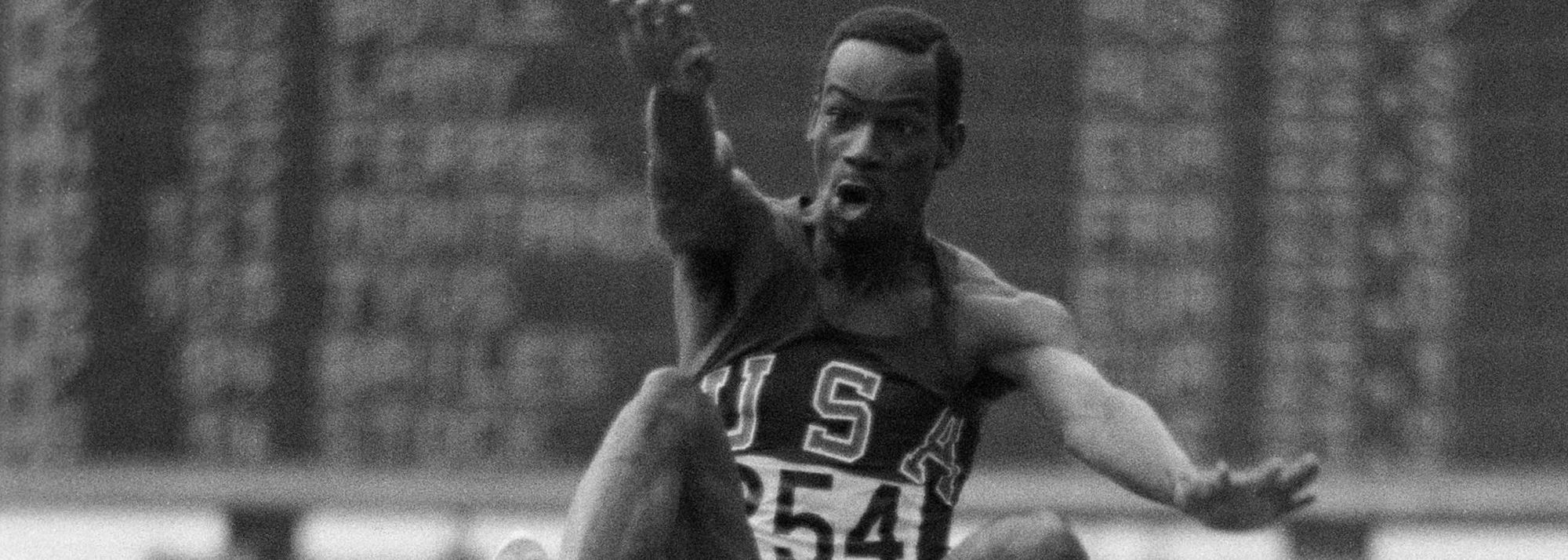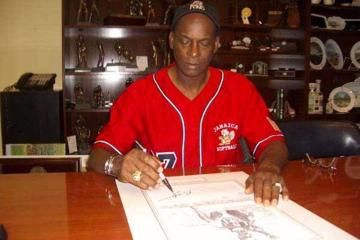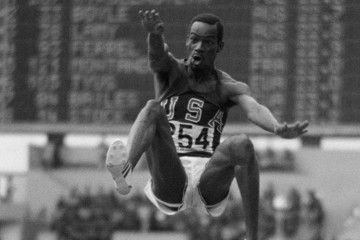Tony Duffy's iconic photograph of Bob Beamon's world record leap in Mexico City (© Getty Images)
The perfect jump. A leap into the 21st century. The greatest sporting achievement of all time.
Those were just a few of the ways that Bob Beamon's astounding 8.90m world record leap in the long jump, set at the Olympic Games in Mexico City 50 years ago today, has been described. His first round effort that day shattered the previous world record by a staggering 55 centimetres as it smashed through both the imperial 28 and 29-foot barriers when he finally broke the sand 29 feet 2½ inches from the edge of the take-off board, beyond even the capabilities of the measuring equipment. After tape measures were found and the distance finally flashed on the scoreboard, Beamon covered his face and fell to the ground, unable to immediately comprehend the magnitude of his achievement.
Nor could others. The jump, and subsequently other equally rare and spectacular sporting achievements since, were simply referred to as 'Beamon-esque'.
It was, at least in part, powered by a perfect storm -- the thin air of Mexico City's helpful 2240m altitude and a maximum 2.0 metre per second allowable wind -- by a man who that season was clearly the finest long jumper on the planet. Beamon arrived in the Mexican capital as the world leader at 8.39m (wind-assisted) and had leaped a career-best 8.33m to move up to No. 2 all-time, having won 22 of his 23 competitions that year. He would never again come remotely close.
For the longest time, neither could anyone else. His record stood for nearly 23 years until it was finally taken down by Mike Powell who leaped 8.95m in his legendary dual with Carl Lewis at the 1991 World Championships in Tokyo. Beamon’s 8.90m remains the second farthest leap of all-time and still the Olympic record.
Mel Watman, a long-time co-editor of Athletics International and a veteran of eight Summer Olympic Games, witnessed Beamon's historic leap and reported on it later for the British publication Athletics Weekly. Below are some of Watman's observations, first from his report in Athletics Weekly (in italics), followed by some reflections as adapted from his 2017 book, 'My Life in Athletics'.
“With one jump Beamon transformed all ideas of what is humanly possible in his event and, by implication, in all others.
But, Watman reminds us, he nearly didn’t make it to the final.
Beamon's long jump was the most incredible of so many startling performances, but he gave his supporters a worrying time in the qualifying round by fouling twice before advancing with 8.19m, second longest behind Ralph Boston's Olympic record of 8.27m. Lynn Davies (of Great Britain) also caused missed heartbeats for he too had two no jumps before qualifying in third place with 7.94m. The final was just three jumps old when Beamon took to the runway. I had my binoculars trained on him and here's how I described what happened next.
Here was the man to be feared, the one who could wrap up the title with an initial jump of 28 feet (8.53m). Fast on the runway (he's a 9.5 100 yards sprinter) the lanky, loose limbed American took off amid gasps of astonishment. Never had such elevation been seen in a long jumper. What mattered though was where he landed, and as he touched down after what was to prove the longest unaided flight by man, the crowd by the pit exploded with excitement. The officials in charge of measurement seemed to be taking an awfully long time so it seemed a pretty good bet that the world record of 8.35m had been bettered, but was it as far as the magical 28 feet? Still no figure flashed on the electrical indicator board, then suddenly everything was happening. Beamon was dancing around, kissing the track even, and fellow competitors dashed over to congratulate him. At last the board flickered into life. The figure 8 flashed up, then a 9 … momentary confusion then the stupefying realisation that the jump was 8.90 metres. A frantic check of the tables … 29 feet 2 inches!
Those among the 60,000-odd spectators present who had witnessed the actual jump knew they had been privileged to see perhaps the greatest single achievement in the entire history of athletics. It could well survive as world record into the 21st century; after all Jesse Owens' 8.13m in 1935 stood for 25 years and that was only six inches better than the previous record. All Beamon had done was to add more than 1 ¾ feet to the mark shared by Ralph Boston and Igor Ter-Ovanesyan. If I hadn't seen it myself I would never have believed it. Several generations are going to have to live with it … the unattainable record.
Bob Ramsak and Mel Watman for the IAAF







